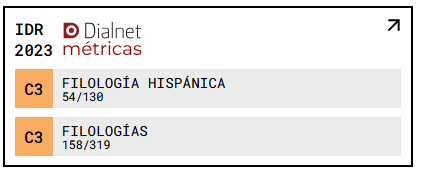“Nothing makes so fine a show as your Greek”: un prefacio a los trasfondos filohelénicos de Poe en “How to Write a Blackwood Article” y “A Predicament”
DOI:
https://doi.org/10.18172/cif.3599Palabras clave:
Poe, A Predicament, Blackwoods, griego, Literatura helénicaResumen
El relato corto “How to Write a Blackwood Article” de Poe y su “The Scythe of Time” llamaron la atención de varios eruditos debido a su conexión innegable y su tono satírico. Estudios como los de Daniel Hoffman y Kenneth Silverman han tomado nota de la sátira de Poe que presenta alusiones a literaturas extranjeras. De hecho, Poe no duda en citar a varios autores extranjeros en el texto, y lo admite de inmediato. Sin embargo, aunque se pueden encontrar estudios como los de Gustav Gruener, Carl F. Schreiber y Susan Levine sobre la influencia alemana y española sobre la obra de Poe, no se han producido investigaciones que exploran sistemáticamente el aspecto helénico del asunto. El presente artículo se centra en la importancia de la lengua y la literatura helénica para los recursos literarios de Poe y también ofrece enlaces adicionales entre “A Predicament” y la mitología helénica que tal vez hayan sido pasados por alto por investigaciones relevantes hasta el momento.
Descargas
Citas
AMPER, S. (1992). “Untold story: The lying narrator in ‘The Black Cat’”. Studies in Short Fiction 29 (4): 475-85.
CAMPBELL, K. (1933). “Three Notes on Poe”. American Literature 4 (4): 385-88. DOI: https://doi.org/10.2307/2919625
DAUGHRITY, K. L. (1930). “Notes: Poe and Blackwoods”. American Literature 2 (3): 289-92.
DISCH, T. (2000). The Dreams Our Stuff Is Made Of: How Science Fiction Conquered the World. New York: Touchstone.
DORO, L. (1944). “Aion”. Hesperia 13 (4): 274. DOI: https://doi.org/10.2307/146699
DROST, C. (2006). Illuminating Poe: The Reflection of Edgar Allan Poe’s Pictorialism in the Illustrations for the Tales of the Grotesque and Arabesque. University of Hamburg: UMI.
GOODMAN, M. (2008). The Sun and The Moon: The Remarkable True Account of Hoaxers, Showmen, Dueling Journalists, and Lunar Man-Bats in Nineteenth-Century New York. New York: Basic Books.
GRUENER, G. (1904). “Poe’s Knowledge of German”. Modern Philology 2 (1): 125. DOI: https://doi.org/10.1086/386631
HANTIU, E. (2010). “Humor and Satire in Edgar Allan Poe’s Absurd Stories”. Edgar Allan Poe Review 11 (2): 28-35. DOI: https://doi.org/10.2307/41506410
HOFFMAN, D. (1972). Poe Poe Poe Poe Poe Poe Poe. New York: Doubleday & Company Inc.
IMPELLUSO, L. (2008). Myths: Tales of the Greek and Roman Gods. New York: Abrams.
KENNEDY, G. J. (Ed.) (2001). A Historical Guide to Edgar Allan Poe. New York: Oxford UP. DOI: https://doi.org/10.1093/oso/9780195121490.001.0001
LEVINE, S. and LEVINE, S. (1986). “‘How-to’ Satire: Cervantes, Marryat, Poe”. Modern Language Studies 16 (3): 15-26. DOI: https://doi.org/10.2307/3194883
MCELRATH, J. R. (1970). “Poe’s Conscious Prose Technique”. NEMLA Newsletter 2 (2): 38-43.
MEYERS, J. (2000). Edgar Allan Poe: His Life and Legacy. New York: Cooper Square.
POE, E. A. (1978). The Collected Works of Edgar Allan Poe, vol. II. (Ed. Thomas Ollive Mabbott). Cambridge: The Belknap Press of Harvard University Press.
POE, E. A. (1838). “‘The Psyche Zenobia” and “The Scythe of Time’”. American Museum 1 (3): 301-17. <http://www.eapoe.org/works/tales/blkwda.htm>
POLLIN, B. (2001). “Poe’s Greek: A Short Prolegomenon to a Long Inquiry.” Edgar Allan Poe Review 2 (2): 71-77.
SANIDOPOULOS, J. (2014). “Edgar Allan Poe As A Philhellene.” Honey and Hemlock. . (Accessed 28 Mar. 2017).
SCHREIDER, C. F. (1930). “Mr. Poe at his Conjurations Again.” The Colophon 2 (1): 1-11.
SILVERMAN, K. (1992). Edgar A. Poe. A Biography. Mournful and Never-Ending Remembrance. London: Weidenfeld & Nicolson.
SOMMERFELD, S. (2012). “Post-Kantian Sublimity and Mediacy in Poe’s ‘Blackwood’ Tales.” The Edgar Allan Poe Review 13 (2): 33-49. DOI: https://doi.org/10.2307/41717104
THOMAS, R. D. and DAVID, K. J. (1987). “Chapter 03” in The Poe Log. Boston: G.K. Hall & Co.
TRIEBER, M. J. (1971). “The Scornful Grin: A Study of Poesque Humor”. Poe Studies: History, Theory, Interpretation 4 (2): 32. DOI: https://doi.org/10.1111/j.1754-6095.1971.tb00169.x
TSAMIS, C. (2009). “ΠΕΡΙ ΧΡΟΝΟΥ [REGARDING TIME]”. Πανελλήνιο Σχολικό Δίκτυο, European Union. <http://users.sch.gr/xtsamis/OkosmosMas/Xronos.htm>. (Accessed 15 October 2016).
VAN DER HORST, P. W. (1999). “Aion” in Dictionary of Deities and Demons in the Bible. Eds. Pieter W. Van Der Horst and Bob Becking. Brill: Eerdmans Publishing Company.
Descargas
Publicado
Cómo citar
Número
Sección
Licencia
El autor o autora conserva todos los derechos sobre su artículo y cede a la revista el derecho de la primera publicación, no siendo necesaria la autorización de la revista para su difusión una vez publicado. Una vez publicada la versión del editor el autor está obligado a hacer referencia a ella en las versiones archivadas en los repositorios personales o institucionales.
El artículo se publicará con una licencia Creative Commons de Atribución, que permite a terceros utilizar lo publicado siempre que se mencione la autoría del trabajo y la primera publicación en esta revista.
Se recomienda a los autores/as el archivo de la versión de editor en repositorios institucionales.














